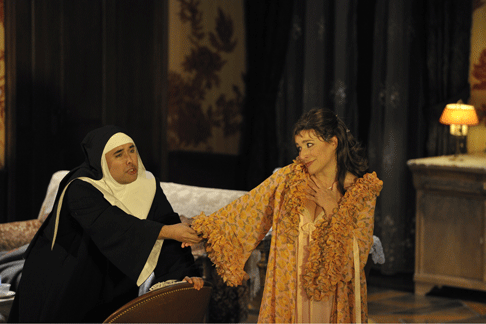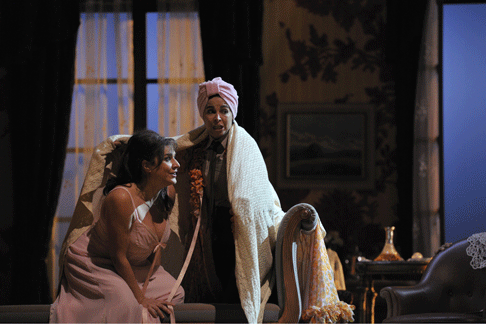And like everything else about her meticulously managed career, La Bartoli has chosen her house wisely since this jewel of a theatre is a perfect size to showcase her prodigious vocal skills. She exudes star quality to be sure, and her acting is fearless and assured, but she also sings up a perfect storm with some of the best damn’ coloratura (rhymes with bravura) fireworks to be heard in this (or any other) galaxy.
The Divine Miss B knows her assets, and her limitations, well and she unerringly maximizes the former and beguiles us into ignoring the latter, by which I mean…the voice is not large. It will never pin us in our seats like Gabriela Schnuat in full Geschrei (Gott sei dank…). But Cecelia is crafty enough not to try, concentrating instead on dazzling with the afore-mentioned pyrotechnical melismas, and by making every phrase supremely meaningful. Some find her minute attention to detail and nuance irritatingly over-reaching and mannered. Not so.
For an example of truly fussy calculations I invite you to listen to the late (late) Schwarzkopf recordings where every syllable has a different life and color (make that “lah-EEF an-duh Cuh-LOoooouuur”). To my ear, our Ms. Bartoli invests each phrase with subtext, and finds exactly the right dramatic modulation within the context of the overall musical moment. As she has matured, her pliable upper voice seems to have become even more flexible all the while it has gotten a little darker, more bronzed now than silvery. The chest tones remain rich, the lower-middle full and responsive, and the role of Countess Adele was superbly realized by a diva in full command of all her resources.
Call it another triumph by this treasurable artist who has gifted the company with another definitive performance. Zurich Opera has repaid our star in kind by surrounding her with a cast of highly talented colleagues and a scintillating production.
Young tenor Javier Camarena was almost all one could wish for in the title role. He sports a secure and easy top, solid technique, decent heft in mid-range, good agility in the florid passage work, and a willingness to throw himself into the stage antics with abandon. True, his forte high notes get quite straight-toned, but they never miss. And he sings very musically with arching line, projecting his well-focused slender voice to the furthest reaches of the house, no matter what comic business he may be doing simultaneously. Mr. Camarena is a highly valuable asset to the repertoire, and he is needed. But damn Juan Diego Florez! Anyone who has experienced JDF in one of these Rossini roles has had the bar of expectation raised impossibly high, not only vocally, but also because he is gorgeous and. . .he can be effortlessly funny. Javier works a little too hard to get har-de-har-laffs and thus distances himself from us. And it has to be said when he peels off his shirt, well, the moment is more Pillsbury Doughboy than Casanova.
Rebeca Olvera was such a secure, perky Isolier and she had such a spot-on delivery that I wanted to love her even more than I did. But I kept thinking what a wonderful Oscar she would make, and wondering if I should be thinking that while she was in front of me essaying the meatier role of Isolier. She strutted and prowled the environment with great conviction, and everything about her crystal-clear bell-like soprano was absolutely first rate. Her duets, singing often in thirds with Bartoli, were among the evening’s most sublime moments. But ultimately, for all her talent and conscientious music-making, we ended up with Isolier-Lite.
 Javier Camarena as Count Ory and Cecilia Bartoli as Countess Adele
Javier Camarena as Count Ory and Cecilia Bartoli as Countess Adele
Not so with the plummy mezzo contribution from Liliana Nikiteanu as Ragonde. Her tone is like a rich cream sauce, and her grounded vocal character was a perfect foil for the other two high flying ladies. Oliver Widmer was a dramatically involved, vocally secure Raimbaud, and he made the most out of his lengthy celebration of wine’s virtues. The ageless veteran Carlos Chausson made his usual solid effort, his ripe bass rolling out securely as the Governor. What a wonderful career he continues to have.
The production was cleverly directed by Moshe Leiser and Patric Caurier, the duo who also scored with Ms. Bartoli’s Clari in this house. Here are two people who know how to direct singers. They know where to place them on stage to be heard. They know how to keep them still (or still enough) to be able to sing well. And they know how to group the chorus and move them so they can maintain good ensemble singing. And…dramatically they know how to use placement of characters and meaningful blocking to properly focus a scene. And Messrs. Leiser and Caurier have created inventive and personalized business while still trusting the material. Sadly, on the international circuit, this is not all that common.
The piece has been set in post-war France and it works surprisingly well. Of course, having the plot hinge around ladies anxiously awaiting their troops coming home from the war invites bitchy comments about not realizing the French ever actually fought in that war…but perhaps that is a little Swiss in-joke. The lovely realistic village setting from designer Christian Fenouillat includes an upper street level that accommodates a number of vehicles to drive across it including a jeep for Isolier and the Governor, and a Citroen for the Countess. A steep set of stairs center stage brings performers to the main level where the Hermit (Ory) is hiding not in a cave, but in a white trash trailer. It later spins and unfolds like a dime store pop up greeting card to reveal a leopard skin and red lamÈ campy camper interior.
Act Two’s palace interior was a brilliantly detailed drawing room with overstuffed sofas and chairs, dining table, copious noveau light fixtures, a balcony, and even a grand piano (which Ory ‘plays’ to accompany himself at one point) . The goof of having the women taking their tea as only one sewed during the ‘sewing chorus’ was charming. Indeed, as Ragonde sloooooooowly threaded the needle while the rest of the ladies hung suspended in silence until the deed was done (to great general relief) , it was an inspired moment of comic invention. And having the chandelier sway during the storm, and various light bulbs “explode” and blow out was one of the many deft touches from lighting designers Christophe Forey and Martin Gebbhardt. The choice of period also allowed for a color-riot of ‘busy’ costumes: day dresses, uniforms, business suits and, of course drag nuns, all of which were lovingly devised by Agostino Cavalca.
 Cecilia Bartoli as Countess Adele and Rebeca Olvera as Isolier
Cecilia Bartoli as Countess Adele and Rebeca Olvera as Isolier
All of the plot points and machinations were extremely well presented, not least of which is Ory’s attempted false seduction of the Countess (in the guise of Isolier). Having the Countess on the floor down stage of the chaise that bears Isolier, the both covered with a blanket, and having Ory approach from upstage was absolutely the right placement, and it allowed good variety in the lengthy scene to boot. The team worked hard and well at filling the repetitive arias (especially Raimbaud’s and Governor’s) with meaningful movement and varied positioning.
The one miscalculation in the concept was that of the character of Count Ory himself. He is sexually adventurous and somewhat insatiable, clear. And he is focused on his pursuits. But he is not a perverted, promiscuous boor with a constant erection. Here, the Count came off as the obnoxious frat boy who was the bane of every party, ogling buttocks, pawing penitents, and even looking up the Countess’ skirt. Mr. Camarena was also oddly costumed in flip-flops, cargo pants and a tee shirt (when he wasn’t the blind hermit). A little finesse would go a long way in fine-tuning Javier’s considerable efforts. A little heart would make him the heart of the show. How ‘bout it, guys? Please?
Conductor Muhai Tang elicited wonderful ensemble playing from the orchestra, finding real rubato and dramatic personality in the odd little overture. He partnered his singers with great aplomb, and the solo work, especially from the winds, was demonstrative and effervescent. J?rg H‰mmerli’s chorus was polished to a fare-thee-well and the many Opera Studio soloists distinguished themselves, notably young tenor Ilker Alcary?rek, a talent to watch.
What a joy it was to see such a seriously well crafted mounting of this seldom encountered comic piece. Rare Rossini, well done!
James Sohre
image=http://www.operatoday.com/ory-80145.gif
image_description=Javier Camarena as Count Ory and Liliana Nikiteanu as Ragonde [Photo by Jef Rabillon courtesy of Opernhaus Z¸rich]
product=yes
product_title=G. Rossini: Le Comte Ory
product_by=Count Ory: Javier Camarena; Countess Adele: Cecilia Bartoli; Isolier: Rebeca Olvera; Ragonde: Liliana Nikiteanu; The Governor: Carlos Chausson; Raimbaud: Oliver Widmer. Conductor: Muhai Tang. Stage Direction: Moshe Leiser and Patric Caurier. Set Design: Christian Fenouillat. Costumes: Agostino Cavalca. Ligthing Design: Christophe Forey and Martin Gebbhardt. Chorus Master: J?rg H‰mmerli.
product_id=Above: Javier Camarena as Count Ory and Liliana Nikiteanu as Ragonde
All photos by Jef Rabillon courtesy of Opernhaus Z¸rich